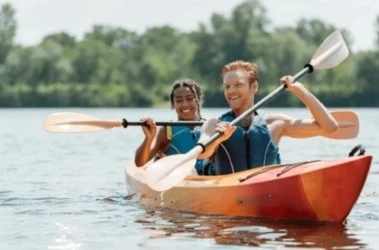Introduction to Kayaking
Kayaking is a popular water sport that involves paddling a small craft, known as a kayak, through water. It's an activity that can be both serene and exhilarating, making it suitable for a wide range of people, from those seeking peaceful encounters with nature to adrenaline junkies looking for their next thrill. Kayaking can be done on various water bodies, including lakes, rivers, and the ocean, each offering a unique experience.
History of Kayaking
The origins of kayaking can be traced back thousands of years to the Inuit and Aleut tribes of Arctic North America. They crafted the first kayaks using driftwood or whalebone frames covered with animal skins. These early kayaks were primarily used for hunting and fishing. The design of these traditional kayaks was so effective that it has remained relatively unchanged, with modern advancements focusing on materials and comfort.
Types of Kayaks
There are several types of kayaks, each designed for specific activities and environments:
Recreational Kayaks: These are perfect for beginners and casual paddlers. They are stable, easy to maneuver, and ideal for calm waters like lakes and slow-moving rivers.Touring Kayaks: Also known as sea kayaks, these are designed for long-distance paddling on open water. They are longer and more streamlined for better speed and tracking.Whitewater Kayaks: These are built for navigating fast-moving, turbulent waters. They are shorter and more maneuverable, allowing paddlers to make quick turns and avoid obstacles.Fishing Kayaks: These are equipped with features like rod holders, extra storage, and stability enhancements to accommodate anglers.Inflatable Kayaks: These are portable and easy to store, making them a convenient option for those with limited storage space or who travel frequently.Essential Gear for Kayaking
To enjoy kayaking safely and comfortably, it's important to have the right gear:
Paddle: A lightweight, durable paddle is essential. The length and style of the paddle will depend on the type of kayaking and the paddler's height.Personal Flotation Device (PFD): Safety is paramount in kayaking. A properly fitting PFD is crucial to ensure buoyancy in case of capsizing.Helmet: For whitewater kayaking, a helmet is necessary to protect against head injuries.Spray Skirt: This is used in sit-in kayaks to keep water out of the cockpit, especially in rough conditions.Appropriate Clothing: Depending on the weather, this could range from a wetsuit or drysuit for cold conditions to moisture-wicking, sun-protective clothing for warm weather.Footwear: Water shoes or sandals with good traction and protection are recommended.Dry Bags: These are used to keep personal belongings dry, such as phones, keys, and extra clothing.Kayak Coolers: Staying Refreshed on the Water
One accessory that has become increasingly popular among kayakers is the kayak cooler. These coolers are designed to fit snugly in a kayak, providing a convenient way to keep food and drinks cold during a day on the water. Here's what you need to know about kayak coolers:
Features of a Good Kayak Cooler
Size and Shape: Kayak coolers come in various sizes, from small lunchbox-sized coolers to larger ones that can hold a day's worth of provisions. The shape should fit the kayak’s storage areas, such as the tank well or cockpit.Insulation: High-quality insulation is crucial for keeping contents cold. Look for coolers with thick walls and high-grade materials.Durability: A kayak cooler should be made from robust materials that can withstand the rigors of outdoor use and exposure to water.Waterproof: The cooler should be waterproof to prevent water from seeping in and compromising the insulation.Attachment Points: Many kayak coolers come with straps or bungee cords to secure them to the kayak, ensuring they stay in place even in rough conditions.Benefits of Using a Kayak Cooler
Convenience: Having a cooler on board allows you to carry perishable items, ensuring you have fresh food and cold beverages available throughout your trip.Extended Trips: For longer excursions, a cooler makes it possible to bring along meals that require refrigeration, enhancing your overall experience.Hydration: Staying hydrated is vital during physical activities like kayaking. A cooler makes it easy to keep water and sports drinks cold and refreshing.Comfort: Access to cold drinks and snacks can greatly enhance comfort and morale, especially on hot days.Tips for Using a Kayak Cooler
Pre-Chill: Pre-chill your cooler and the items you plan to pack. This helps maintain the cold temperature longer.Ice Packs: Use reusable ice packs instead of loose ice to minimize water buildup inside the cooler.Packing Order: Place heavier items at the bottom and lighter, more frequently accessed items on top for easy retrieval.Secure Properly: Ensure the cooler is securely attached to the kayak to prevent it from shifting or tipping over.Conclusion
Kayaking is a versatile and rewarding activity that offers numerous benefits, from physical fitness to mental relaxation. Whether you're paddling through tranquil lakes, navigating whitewater rapids, or exploring coastal waters, having the right equipment, including a reliable kayak cooler, can enhance your experience. So, gear up, stay safe, and enjoy the adventure of kayaking!


